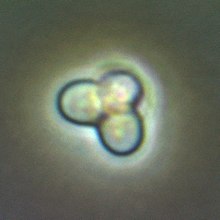Cyanidioschyzon merolae
| Cyanidioschyzon merolae | |
|---|---|
 |
|
| Scientific classification | |
| Domain: | Eukaryota |
| (unranked): | Archaeplastida |
| Division: | Rhodophyta |
| Class: | Cyanidiophyceae |
| Order: | Cyanidiales |
| Family: | Cyanidiaceae |
| Genus: | Cyanidioschyzon |
| Binomial name | |
|
Cyanidioschyzon merolae P.De Luca, R.Taddei & L.Varano |
|
Cyanidioschyzon merolae is a small (2μm), club-shaped, unicellular haploid red alga adapted to high sulfur acidic hot spring environments (pH 1.5, 45 °C). The cellular architecture of C. merolae is extremely simple, containing only a single chloroplast and a single and lacking a vacuole and cell wall. In addition, the cellular and organelle divisions can be synchronized. For these reasons, C. merolae is considered an excellent model system for study of cellular and organelle division processes, as well as biochemistry and structural biology. The organism's genome was the first full algal genome to be sequenced in 2004; its plastid was sequenced in 2000 and 2003, and its mitochondrion in 1998. The organism has been considered the simplest of eukaryotic cells for its minimalist cellular organization.
Originally isolated by De Luca in 1978 from the solfatane fumaroles of Campi Flegrei (Naples, Italy),C. merolae can be grown in culture in the laboratory in Modified Allen’s medium (MA) or a modified form with twice the concentration of some elements called MA2. Using MA medium, growth rates are not particularly fast, with a doubling time (the time it takes a culture of microbes to double in cells per unit volume) of approximately 32 hours. By using the more optimal medium MA2, this can be reduced to 24 hours. Culturing is done at 42 °C under white fluorescent light with an approximate intensity of 50 µmol photons m−2 s−1 (µE). However, under a higher light intensity of 90 µE with 5% CO2 applied through bubbling, the growth rate of C. merolae can be further increased, with a doubling time of approximately 9.2 hours. Higher light is not necessarily beneficial, as above 90 µE the growth rate begins to decrease. This may be due to photodamage occurring to the photosynthetic apparatus. C. merolae can also be grown on gellan gum plates for purposes of colony selection or strain maintenance in the laboratory.C. merolae is an obligate oxygenic phototroph, meaning it is not capable of taking up fixed carbon from its environment and must rely on oxygenic photosynthesis to fix carbon from CO2.
...
Wikipedia
